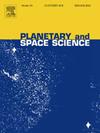Kinetic theory for rings around oblate central bodies
IF 1.7
4区 物理与天体物理
Q3 ASTRONOMY & ASTROPHYSICS
引用次数: 0
Abstract
We apply kinetic theory (KT) to solve for the vertical structure of an axisymmetric, self-gravitating, particulate ring around a spheroidal central body which may be either spherical or oblate. Our work improves upon the present KT models of rings by introducing a more general central body potential. We consider both dilute and dense rings. As an example for a dilute ring, we solve for the vertical structure of Saturn’s A ring including Saturn’s oblateness in our calculations. We compare our results with earlier works (Simon and Jenkins 1994) which assumed a spherical Saturn. Then, we calculate the corrections due to the oblateness on the ring stability condition obtained by them. We find that the planetary oblateness adversely affects ring stability due to the enhanced shearing. Next, we add self-gravity as an additional vertical force in dilute rings, where particle clumping is negligible, and find the combined stability boundary. Self-gravity is seen to have a stabilising effect on the ring as reported in earlier studies (Salo 1995), though, its stabilising effect is observed to be less than the destabilising effect of the oblateness of the central body, at least, for dilute rings. Then, we move to moderately dense rings. Oblateness of the central body is seen to perturb the ring properties, and, the results indicate a good qualitative comparison with DE simulations of Gupta et al., (2018). However, we note the emergence of strong self-gravity wakes in dense rings, an aspect that is usually ignored in kinetic theory for rings. Hence, we show the need for improved constitutive modelling of rings including the mesoscopic inhomogeneities in the form self-gravity wakes. Finally, we apply KT to solve for the vertical structure of Chariklo’s inner ring. Through this we estimate the 1/3 resonance torque of Chariklo that acts on the inner boundary of Chariklo’s inner ring by calculating the shear stress in the ring. Overall, our work demonstrates the structural differences of rings around minor planets like Chariklo that have highly oblate shapes.
围绕扁中心体的环的动力学理论
我们应用动力学理论(KT)求解了一个轴对称的、自重力的、围绕一个球形或扁圆形中心体的微粒环的垂直结构。我们的工作改进了现有环的KT模型,引入了更一般的中心体势。我们同时考虑稀环和密环。以稀环为例,我们在计算中考虑了土星的扁率,求解了土星a环的垂直结构。我们将我们的结果与早期的工作(Simon and Jenkins 1994)进行比较,后者假设土星是球形的。然后,我们计算了由它们得到的环稳定性条件的扁率修正。我们发现由于剪切作用的增强,行星扁率对环的稳定性有不利影响。接下来,我们在稀环中加入自重力作为额外的垂直力,其中粒子团块可以忽略不计,并找到组合稳定性边界。在早期的研究中(Salo 1995),自重力被认为对环有稳定作用,尽管它的稳定作用被观察到小于中心天体扁率的不稳定作用,至少对稀释的环来说是这样。然后,我们移动到中等密度的环。中心物体的扁率被认为扰乱了环的性质,并且,结果表明与Gupta等人(2018)的DE模拟有很好的定性比较。然而,我们注意到密集环中出现了强自重力尾迹,这是环动力学理论中通常忽略的一个方面。因此,我们表明需要改进环的本构模型,包括自重力尾迹形式的介观不均匀性。最后,应用KT法求解了Chariklo内环的垂直结构。由此,通过计算Chariklo内环的剪切应力,估计出Chariklo内环内边界上作用的1/3共振力矩。总的来说,我们的工作证明了像Chariklo这样具有高度扁圆形状的小行星周围环的结构差异。
本文章由计算机程序翻译,如有差异,请以英文原文为准。
求助全文
约1分钟内获得全文
求助全文
来源期刊

Planetary and Space Science
地学天文-天文与天体物理
CiteScore
5.40
自引率
4.20%
发文量
126
审稿时长
15 weeks
期刊介绍:
Planetary and Space Science publishes original articles as well as short communications (letters). Ground-based and space-borne instrumentation and laboratory simulation of solar system processes are included. The following fields of planetary and solar system research are covered:
• Celestial mechanics, including dynamical evolution of the solar system, gravitational captures and resonances, relativistic effects, tracking and dynamics
• Cosmochemistry and origin, including all aspects of the formation and initial physical and chemical evolution of the solar system
• Terrestrial planets and satellites, including the physics of the interiors, geology and morphology of the surfaces, tectonics, mineralogy and dating
• Outer planets and satellites, including formation and evolution, remote sensing at all wavelengths and in situ measurements
• Planetary atmospheres, including formation and evolution, circulation and meteorology, boundary layers, remote sensing and laboratory simulation
• Planetary magnetospheres and ionospheres, including origin of magnetic fields, magnetospheric plasma and radiation belts, and their interaction with the sun, the solar wind and satellites
• Small bodies, dust and rings, including asteroids, comets and zodiacal light and their interaction with the solar radiation and the solar wind
• Exobiology, including origin of life, detection of planetary ecosystems and pre-biological phenomena in the solar system and laboratory simulations
• Extrasolar systems, including the detection and/or the detectability of exoplanets and planetary systems, their formation and evolution, the physical and chemical properties of the exoplanets
• History of planetary and space research
 求助内容:
求助内容: 应助结果提醒方式:
应助结果提醒方式:


